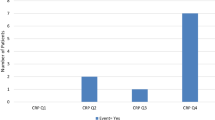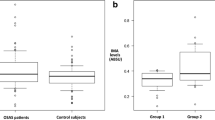Abstract
Purpose
Previous studies have shown a relationship between obstructive sleep apnea (OSA) and erythrocyte sedimentation rate (ESR), a representative marker for inflammation. We aimed to elucidate the possible association between elevated ESR and OSA severity.
Methods
A total of 341 patients who visited a sleep center were retrospectively enrolled. Subjects underwent physical examination, overnight polysomnography (PSG), and blood sampling for ESR and high-sensitivity C-reactive protein (hs-CRP). We compared the ESR and hs-CRP level to OSA severity and measured their correlation with other PSG parameters.
Results
The ESR was significantly higher in patients with severe OSA (apnea–hypopnea index (AHI) ≥ 30) than those with simple snoring (AHI < 5; P = 0.016), mild OSA (5 ≤ AHI < 15; P = 0.010), and moderate OSA (15 ≤ AHI < 30; P = 0.042). Similarly, the hs-CRP level in patients with severe OSA was significantly higher than that in patients with simple snoring (P = 0.006) and mild OSA (P = 0.013). Multivariate analysis also showed that elevated ESR was associated with moderate and severe OSA (adjusted OR = 2.231 (P = 0.048) and 2.606 (P = 0.002), respectively) after adjusting for sex, age, body mass index, smoking, hypertension, diabetes mellitus, and hyperlipidemia. However, elevated hs-CRP was not associated with the OSA severity.
Conclusions
ESR more closely correlated with PSG parameters recorded during sleep hypoxic episodes than hs-CRP. Moreover, the ESR may be useful to predict the OSA severity because moderate and severe OSA were independently associated with an elevated ESR.

Similar content being viewed by others
References
Guilleminault C, Tilkian A, Dement WC (1976) The sleep apnea syndromes. Annu Rev Med 27:465–484. doi:10.1146/annurev.me.27.020176.002341
Del Ben M, Fabiani M, Loffredo L, Polimeni L, Carnevale R, Baratta F, Brunori M, Albanese F, Augelletti T, Violi F, Angelico F (2012) Oxidative stress mediated arterial dysfunction in patients with obstructive sleep apnoea and the effect of continuous positive airway pressure treatment. BMC Pulmonary medicine 12:36. doi:10.1186/1471-2466-12-36
Khayat R, Patt B, Hayes Jr D (2009) Obstructive sleep apnea: the new cardiovascular disease. Part I: obstructive sleep apnea and the pathogenesis of vascular disease. Heart Fail Rev 14(3):143–153. doi:10.1007/s10741-008-9112-z
McNicholas WT (2009) Obstructive sleep apnea and inflammation. Prog Cardiovasc Dis 51(5):392–399. doi:10.1016/j.pcad.2008.10.005
Hartmann G, Tschop M, Fischer R, Bidlingmaier C, Riepl R, Tschop K, Hautmann H, Endres S, Toepfer M (2000) High altitude increases circulating interleukin-6, interleukin-1 receptor antagonist and C-reactive protein. Cytokine 12(3):246–252. doi:10.1006/cyto.1999.0533
Imoberdorf R, Garlick PJ, McNurlan MA, Casella GA, Peheim E, Turgay M, Bartsch P, Ballmer PE (2001) Enhanced synthesis of albumin and fibrinogen at high altitude. J Appl Physiol 90(2):528–537
Natali A, L'Abbate A, Ferrannini E (2003) Erythrocyte sedimentation rate, coronary atherosclerosis, and cardiac mortality. Eur Heart J 24(7):639–648
Shamsuzzaman AS, Winnicki M, Lanfranchi P, Wolk R, Kara T, Accurso V, Somers VK (2002) Elevated C-reactive protein in patients with obstructive sleep apnea. Circulation 105(21):2462–2464
Yokoe T, Minoguchi K, Matsuo H, Oda N, Minoguchi H, Yoshino G, Hirano T, Adachi M (2003) Elevated levels of C-reactive protein and interleukin-6 in patients with obstructive sleep apnea syndrome are decreased by nasal continuous positive airway pressure. Circulation 107(8):1129–1134
Ridker PM, Rifai N, Rose L, Buring JE, Cook NR (2002) Comparison of C-reactive protein and low-density lipoprotein cholesterol levels in the prediction of first cardiovascular events. N Engl J Med 347(20):1557–1565. doi:10.1056/NEJMoa021993
Arias MA, Garcia-Rio F, Alonso-Fernandez A, Hernanz A, Hidalgo R, Martinez-Mateo V, Bartolome S, Rodriguez-Padial L (2008) CPAP decreases plasma levels of soluble tumour necrosis factor-alpha receptor 1 in obstructive sleep apnoea. The European Respiratory Journal 32(4):1009–1015. doi:10.1183/09031936.00007008
Minoguchi K, Tazaki T, Yokoe T, Minoguchi H, Watanabe Y, Yamamoto M, Adachi M (2004) Elevated production of tumor necrosis factor-alpha by monocytes in patients with obstructive sleep apnea syndrome. Chest 126(5):1473–1479. doi:10.1378/chest.126.5.1473
Ryan S, Taylor CT, McNicholas WT (2006) Predictors of elevated nuclear factor-kappaB-dependent genes in obstructive sleep apnea syndrome. Am J Respir Crit Care Med 174(7):824–830. doi:10.1164/rccm.200601-066OC
Min JY, Jang JY, Kim HY, Lee WY, Dhong HJ, Chung SK, Chung SC (2009) A relationship between the obstructive sleep apnea syndrome and the erythrocyte sedimentation rate. Clinical and Experimental otorhinolaryngology 2(3):126–130. doi:10.3342/ceo.2009.2.3.126
Yardim-Akaydin S, Caliskan-Can E, Firat H, Ardic S, Simsek B (2014) Influence of gender on C-reactive protein, fibrinogen, and erythrocyte sedimentation rate in obstructive sleep apnea. Anti-Inflammatory & anti-Allergy Agents in Medicinal Chemistry 13(1):56–63
Sleep-related breathing disorders in adults: Recommendations for syndrome definition and measurement techniques in clinical research. The report of an American Academy of Sleep Medicine Task Force (1999). Sleep 22 (5):667–689
Lavie L, Lavie P (2009) Molecular mechanisms of cardiovascular disease in OSAHS: the oxidative stress link. The European Respiratory journal 33(6):1467–1484. doi:10.1183/09031936.00086608
Castell JV, Gomez-Lechon MJ, David M, Fabra R, Trullenque R, Heinrich PC (1990) Acute-phase response of human hepatocytes: regulation of acute-phase protein synthesis by interleukin-6. Hepatology 12(5):1179–1186
Peled N, Kassirer M, Kramer MR, Rogowski O, Shlomi D, Fox B, Berliner AS, Shitrit D (2008) Increased erythrocyte adhesiveness and aggregation in obstructive sleep apnea syndrome. Thromb Res 121(5):631–636. doi:10.1016/j.thromres.2007.07.010
Marin JM, Carrizo SJ, Vicente E, Agusti AG (2005) Long-term cardiovascular outcomes in men with obstructive sleep apnoea-hypopnoea with or without treatment with continuous positive airway pressure: an observational study. Lancet 365(9464):1046–1053. doi:10.1016/S0140-6736(05)71141-7
Yaggi HK, Concato J, Kernan WN, Lichtman JH, Brass LM, Mohsenin V (2005) Obstructive sleep apnea as a risk factor for stroke and death. N Engl J Med 353(19):2034–2041. doi:10.1056/NEJMoa043104
Funding
The authors have no support or funding to report.
Conflict of interest
The authors declare that they have no competing interests.
Compliance with Ethical Standards
All procedures performed in studies involving human participants were in accordance with the ethical standards of the institutional and/or national research committee and with the 1964 Helsinki Declaration and its later amendments or comparable ethical standards. For this type of study, formal consent is not required.
Author information
Authors and Affiliations
Corresponding author
Rights and permissions
About this article
Cite this article
Lee, W.H., Wee, J.H., Rhee, CS. et al. Erythrocyte sedimentation rate may help predict severity of obstructive sleep apnea. Sleep Breath 20, 419–424 (2016). https://doi.org/10.1007/s11325-015-1245-4
Received:
Revised:
Accepted:
Published:
Issue Date:
DOI: https://doi.org/10.1007/s11325-015-1245-4




